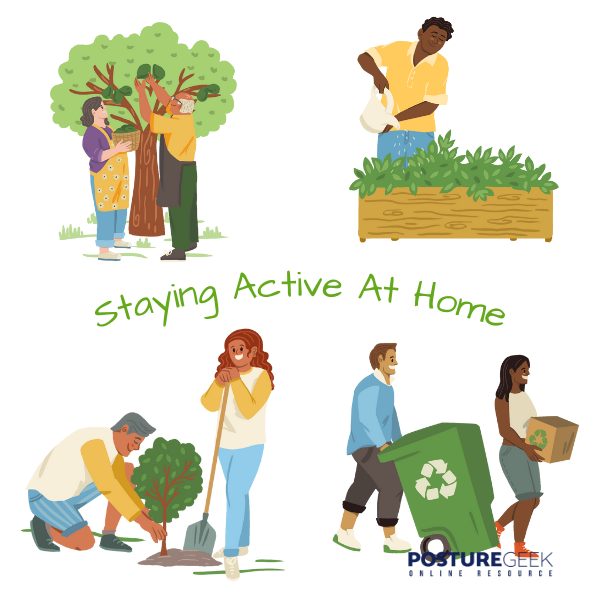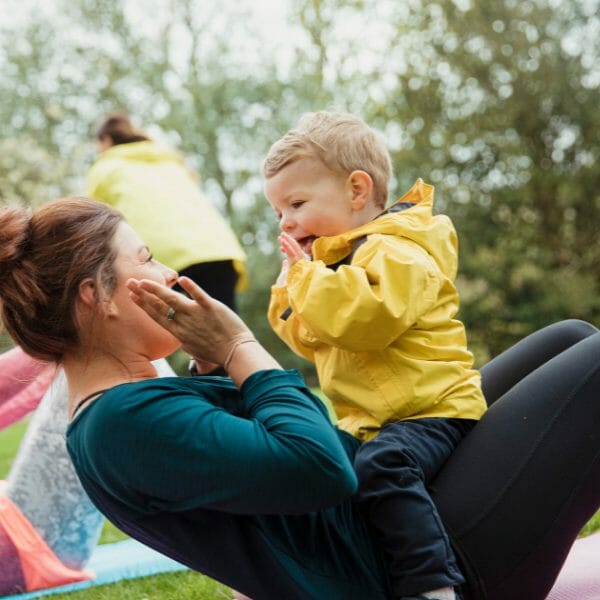Stay Active: Why Moving Your Body Is Key To Staying Young And Healthy.
It’s no secret that moving your body is key to staying young and healthy. In fact, it’s something we’ve been told since we were children. But many of us still find excuses not to move as much as we should.
We say things like “I’m too busy” or “I don’t have time.” The truth is, there are plenty of ways to stay active and move your body without spending hours at the gym.
What are some of the health benefits of staying active?

There are many other reasons why it is essential to stay physically active. Still, these are just a few of the most important ones. Moving your body helps:
Improve your overall health and wellness
Exercise has so many benefits that impact your overall health and wellness. It can help improve cardiovascular health, increase strength and flexibility, reduce stress, improve sleep quality, and boost mood.
PostureGeek.com Tweet
Exercise has so many benefits that impact your overall health and wellness. It can help improve cardiovascular health, increase strength and flexibility, reduce stress, improve sleep quality, and boost mood. All these health benefits work together to help you live healthier and happier lives.
Basically, you are what you do most. So get up and move! Your body will thank you for it.
Reduce your risk of chronic diseases
There are plenty of chronic diseases out there that can be lessened or even prevented by simply moving your body. These include heart disease, stroke, diabetes, cancer, and arthritis. Furthermore, exercise has been shown to improve mental health and memory function. So not only will staying active keep your body healthy, but it will also keep your mind sharp. Win-win!
Maintain a healthy weight
Exercise can help you maintain a healthy weight by burning calories and building muscle. However, if you are carrying extra weight, it puts additional strain on your heart, lungs, and joints. If you lose weight, you can help improve your overall health and reduce your risk of developing obesity-related conditions, such as type II diabetes, heart disease, high blood pressure, and certain types of cancer.
Get strong bones and muscles
Regular physical activity can help to build strong bones and muscles. This is especially important for older adults at a higher risk for developing osteoporosis (a condition that causes bones to become weak and brittle). In addition, strength-training exercises can help build muscle mass and improve balance, which can help reduce the risk of falls.
Reduce your risk of chronic diseases
Chronic diseases such as heart disease, stroke, and type II diabetes are some of the leading causes of death in the United States. However, regular physical activity can help to reduce your risk of developing these conditions. For example, exercise can improve cholesterol levels, blood pressure, and blood sugar control. It can also help lower your stress levels and improve your mental health.
Improve your mental health and mood
Exercise releases endorphins, which have mood-boosting effects. Research has shown that people who exercise regularly have lower rates of depression and anxiety. Regular physical activity can also help improve your sleep quality. These health benefits can lead to a better overall sense of well-being.
You stay flexible and agile
The more you move your body, the more flexible and agile you will stay. This is especially important as you age when your risk of injury increases. Even if you can’t do strenuous physical activity, simply going for a walk or doing some light stretching can make a big difference in your overall health. So get moving today – your body will thank you for it!
Improve your circulation
Your circulatory system is responsible for carrying oxygen and nutrients to your cells and removing waste products. Exercise helps keep your blood flowing smoothly by increasing your heart rate and improving the function of your arteries. This can help reduce your risk of heart disease, stroke, and other circulation problems.
Physical activities: what are some ways that you can get started?
Good posture is essential for overall health, but it's especially important for the respiratory system. When you have proper posture habits, your rib cage allows your lungs more room to expand and contract.
PostureGeek.com Tweet

So, as you can see, there are many good reasons to stay active! But how do you get started? If you’re not used to being active, starting slowly and gradually increasing your activity level over time is essential. Here are a few tips:
Start with simple activities
Moderate intensity aerobic activity like walking, gardening, or even household chores can be a great way to get started.
Find an activity you enjoy
If you find an activity you enjoy, you’ll be more likely to stick with it.
Set realistic physical activity goals
Don’t try to do too much too soon. Set small goals and then gradually increase your activity level.
Find a buddy
Exercise is more fun with a friend! Find someone who shares your interest in being active and exercise together.
Join a Gym
A gym can be a great place to get started with an exercise program. Many gyms offer a variety of classes, so you can find one that’s right for you.
Stay Motivated
It’s important to find ways to stay motivated when you’re trying to be more active. setting goals, tracking your progress, and rewarding yourself for meeting your goals can help you stay on track.
Get active with your kids
Playing with your kids is a great way to get active and have fun at the same time!
Invest in a pedometer or fitness tracker
A pedometer can help you track your steps and see how much physical activity you get each day. A fitness tracker can do this and track other activities such as heart rate, calories burned, and more.
Make household chores into a workout
Vacuuming, mopping, and even doing laundry can be a great workout if you do them with intention.
A Physical activity guidelines list

Healthy adults should aim for at least 150 minutes of moderate-intensity aerobic activity per week. This can be done in a few sessions or smaller increments throughout the week. And don’t forget to add some strength-training exercises into the mix! Regular physical activity is one of the best things you can do for your health, so get moving today!
In the USA, The Centers for Disease Control and Prevention (CDC) recommends that adults get at least two hours and thirty minutes of moderate aerobic activity or one hour and fifteen minutes of vigorous aerobic activity per week. They also recommend that adults do muscle-strengthening activities on two or more days per week.
Here are some examples of moderate-intensity aerobic activity:
- Steady walking pace (at least three miles per hour)
- Water aerobics
- Riding a bike on level ground or with few hills
- Introductory yoga class
Here are some examples of vigorous aerobic activities:
- Jogging or running
- Swimming laps
- Riding a bike fast or on hills
Remember, you can also do a combination of moderate and vigorous aerobic activity. And, you don’t have to do it all at once. Instead, you can break it up into smaller chunks of time throughout the day.
Here are some examples of muscle-strengthening activities:
- Lifting weights
- Working with resistance bands
- Doing push-ups or sit-ups
- Heavy gardening, such as digging and shovelling
Now that you know the guidelines, it’s time to get out there and get active! Just remember to start slowly and increase your activity level gradually. And, always check with your doctor before starting a new physical activity program.
REMINDER: Checklist of things you can do to get started with an exercise routine

- Choose an activity or two from the list above and commit to doing them on a regular basis.
- Join a gym, class, or online fitness program.
- Get active with your kids.
- Invest in a pedometer or fitness tracker.
- Make household chores into a workout.
- Talk to your doctor about creating a physical activity plan.
- Find a friend or family member to be your workout buddy.
- Check out local parks and recreation programs.
- Use fitness apps or online resources.
- Participate in workplace wellness programs.
- Check with your insurance company for wellness programs.
- Make physical activity a part of your daily routine.
- Wear appropriate workout gear
Who can help you stay active?
There are many people who can help you stay active.
Your Doctor
Your doctor can help you create a physical activity plan that is right for you.
A Certified Personal Trainer
A certified personal trainer can teach you how to safely and effectively exercise. They can also design an exercise program that is tailored to your individual needs.
A Physical Therapist
A physical therapist can help you safely return to activity if you have an injury or a medical condition.
An Exercise Class Instructor
Exercise classes are a great way to get active and have fun at the same time. Many gyms and community centers offer a variety of classes, such as a yoga class, Pilates, aerobics, and more.
A Fitness App
Many fitness apps can help you track your activity, set goals, and more.
An Online Fitness Program
Many online fitness programs can help you get started with an exercise program.
Your Family and Friends
Family and friends can be a great source of motivation to stay active. They can also help you stay accountable to your physical activity outcomes.
What kind of local organizations can help?
There are many local organizations that can help you stay active.
Your local parks and recreation department
Your local parks and recreation department can offer a variety of programs and activities to help you stay active.
Your local YMCA or community center
YMCAs and community centers offer a variety of programs, classes, and facilities to help you stay active.
Your local fitness center
Fitness centers offer a variety of programs and equipment to help you stay active.
Your local library
Libraries often have resources, such as books, DVDs, and classes, that can help you stay active.
Your workplace wellness program
Many workplaces offer wellness programs that include physical activity components.
Your insurance company
Some insurance companies offer programs that can help you stay active.
The bottom line
No matter what your age, it’s important to move your body and stay active. The more you move, the better off you’ll be physically and mentally. And, there are many people who can help you stay active – from your doctor to a personal trainer to an exercise class instructor. So get out there and start moving!
PLEASE NOTE
PostureGeek.com does not provide medical advice. This information is for educational purposes only and is not intended to be a substitute for professional medical attention. The information provided should not replace the advice and expertise of an accredited health care provider. Any inquiry into your care and any potential impact on your health and wellbeing should be directed to your health care provider. All information is for educational purposes only and is not intended to be a substitute for professional medical care or treatment.
